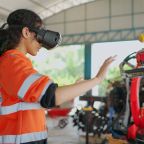Learning reinforcement is a training strategy that engages learners both before and after their principle learning activity through pre-work and/or post-work (e.g. reading informational articles, writing in a journal, printing out a job aid, etc.).
Pre-work activities introduce training topics and prepare learners for the principle learning activity, while post-work supports training content by challenging learners to think about how they’ll apply what they’ve learned to their role.
The goal of learning reinforcement is to improve knowledge retention by prompting the application of key learning concepts. This application of learning helps employees put what they’ve learned into practice, ultimately leading to sustained behavior change that positively impacts an organization.
Did you know that learners forget 90% of what they’ve learned within the first month after training if their learning isn’t properly reinforced?
The good news is that learning reinforcement counteracts this curve. Learning reinforcement helps learners retain information for longer periods of time, master learning objectives, and continue applying what they’ve learned to their daily job duties.
At Roundtable Learning, we’ve helped organizations across the U.S. design and implement custom training programs that meet the needs of their learners. We know that surrounding principle learning activities with learning reinforcement activities yields the best results by engaging your workforce and boosting knowledge retention.
This article will define learning reinforcement, explore its importance, and break down how to incorporate learning reinforcement into training.
What Is Learning Reinforcement?
Learning reinforcement is a training strategy that engages learners both before and after their main learning activity through pre-work and/or post-work (e.g. reading informational articles, writing in a journal, printing out a job aid, etc.).
Learning reinforcement supplements the principle learning activity of a training program through pre- and post-session activities that reinforce key objectives. These reinforcement activities are equally as important as the principle learning activity and help boost knowledge retention, engage employees, and drive sustained behavior changes.
Why Is Learning Reinforcement Important?
Learning reinforcement is important because it helps employees put what they’ve learned into action, allowing them to retain more information for longer periods of time after the program ends. Without learning reinforcement, learners risk forgetting 90% of what they’ve learned within the first month after training.
When learners are more active in their learning process and participate in reinforcement activities, organizations see the following benefits:
- Higher knowledge retention rates for longer periods of time
- Higher employee productivity
- Decreased employee turnover
It’s imperative that learners are actively involved in the learning process both before and after the principle learning activity so that they can apply and review what they’ve learned to help the material stick.
Read More: Why Post-Training Reinforcement Can’t Be Overlooked
How To Incorporate Learning Reinforcement Into Your Training
To help visualize learning reinforcement in the context of blended learning, let’s use an OREO. The main premise of the OREO theory is that although the center may be the main area of focus, you need the outer 2 layers to make the cookie whole.
Let’s break down each layer!
Pre-Work Activities — First Chocolate Cookie Layer
The first cookie layer of the OREO represents pre-work activities that occur before the main learning activity.
These pre-work activities could include any of the following:
- Read informational articles
- Watch educational videos
- Answer questions that evoke critical thinking
- Read a case study
- Complete eLearning modules
- Review an example and come to the session ready to discuss
The purpose of pre-work activities is to prepare learners for the main learning activity by stimulating their minds and introducing them to learning objectives and topics they will encounter throughout the training.
Principle Learning Activity — Middle Icing Layer
The icing layer in the center of the OREO cookie represents the principle learning activity. This session is where the main learning objectives are met and will be the majority of your training. The principle learning activity can come in the form of instructor-led training (ILT), virtual reality (VR) activities, eLearning, and so on.
Although this layer is the glue for a training program, the other two outer cookie layers are just as important. The outer layers give the cookie form and strengthen it, just as pre- and post-session activities reinforce and engage learners before and after the principle learning activity.
The purpose of the principle learning activity is to put ideas into practice through hands-on, engaging learning activities. This is where key learning objectives are met and learners understand the practical applications of the knowledge they’re acquiring.
Post-Work Activities — Second Chocolate Cookie Layer
The third layer of our OREO cookie focuses on post-work that learners complete after the main learning activity to reinforce their understanding. This reinforcement layer follows the mantra: if learners don’t use it, they’ll lose it.
Post-work activities could include any of the following:
- Write in a learning journal
- Read an informational article, then reflect on it to think more deeply about the topic
- Complete a conversation guide with a partner
- Participate in weekly study sessions where learners answer contextualized prompts and discuss with each other
- Create an action plan that forces learners to think, reflect, and plan how they’re going to use what they’ve learned
- Provide a job aid
- Send a follow-up email explaining how participants can use what they learned and engage their new skills
This outer layer involves activities that reinforce the knowledge acquired during the main learning activity. Learners test their understanding of information and learn how to apply what they’ve learned to their role.
Optimize Your Training Program With Learning Reinforcement
We hope that by reading this article, you’ve become aware of the benefits of learning reinforcement and can find ways to apply it to your organization’s training program.
Ready to start designing your own custom training program? Schedule a meeting with our team of experts to learn more and kick off your training program today!








